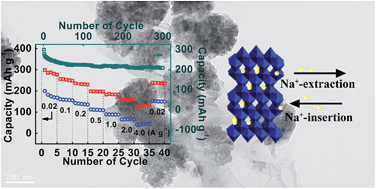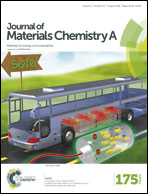Graphene-supported TiO2 nanospheres as a high-capacity and long-cycle life anode for sodium ion batteries†
Abstract
Anatase TiO2 has low-cost and potentially high capacity as a Na-storage anode, but its low capacity utilization and poor rate capability remain a challenge for practical battery applications. To address this issue, we synthesized graphene-supported TiO2 nanospheres through a facile hydrothermal process, aiming at enhancing the electrochemical capacity and kinetics of this material. The porous TiO2 nanospheres offer abundant electrochemically active surface sites and ionic channels, enabling high utilization of the TiO2 nanoparticles, meanwhile the rGO matrices provide high electronic conduction and prevent the aggregation of the TiO2 nanoparticles during repeated cycles. The as-prepared rGO–TiO2 electrode demonstrates a high capacity of 300 mA h g−1 and a cycling stability with a capacity retention of 208 mA h g−1 over 300 cycles. Also, this rGO–TiO2 electrode exhibits a high rate capability of 123.1 mA h g−1 at a very high rate of 4.0 A g−1. The structural design and synthesis route described in this work may provide an effective approach to promote the electrochemical performance of Na-insertion materials for high-rate and high capacity Na-ion batteries.


 Please wait while we load your content...
Please wait while we load your content...